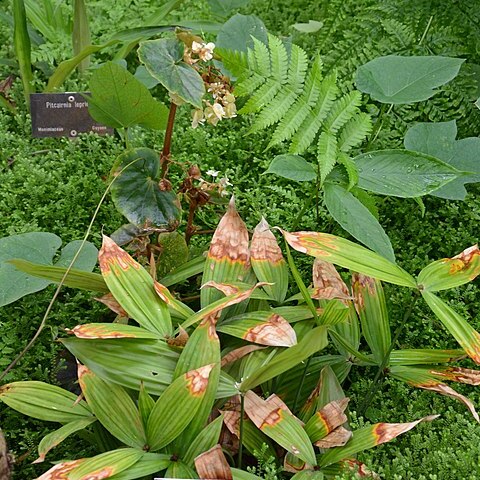Perennial, usually coarse herbs. Rhizome woody, erect, obliquely erect, or horizontal (sometimes up to 2 m long); long-creeping stolons covered with lanceolate, acute scales rarely present; roots usually thick, greyish brown to blackish, sometimes functioning as stilt roots. Flowering stems either central (arising from the centre of a basal tuft of leaves), erect, triquetrous, usually with 1-2 cauline leaves, or lateral (scapes), arising from the axils of the lower (rarely also higher) leaves or from below the leaves, trigonous or terete, the base clothed with some bladeless scale-like sheaths. Leaves 3-ranked, subcoriaceous to thickly coriaceous, linear, broadly linear, or lorate, slightly narrowed towards the conduplicate base, or rather abruptly narrowed into a petiole, the top (in almost all Mal. spp.) very gradually to abruptly narrowed into a filiform, triquetrous, scabrous tail; margins and midrib (rarely also 2 lateral nerves) aculeate-scabrous; midrib prominent beneath, 2 (rarely more) lateral nerves often prominent above. Inflorescence either consisting of a single spikelet or capitate (i.e. consisting of few to numerous sessile spikelets), in the latter case surrounded by some glume-like or foliaceous involucral bracts. Glumes spirally imbricate, coriaceous, chartaceous, or membranous, lower ones empty, upper ones flower-bearing. Flowers hermaphrodite, linear, strongly dorsiventrally compressed. Hypogynous scales (in the Mal. spp.) 6, thinly membranous, the lowest 2 transversal, opposite, free, rarely connate on the adaxial side, boat-shaped, ciliate on the acute or narrowly winged keel, each with a stamen in its axil, the third (anticous one) concave or 2-keeled, also with a stamen in its axil, the remaining 3 concave or flat, empty; in extra-Malesian spp. the number of scales and stamens less constant. Anthers linear; connective only shortly produced. Style continuous with the ovary, not or hardly incrassate at the base; stigmas 3, more rarely 2. Nut terete or slightly angular, beaked, stipitate; exocarp thick, corky or fleshy; endocarp stony, black.
More
Herbs, perennial, robust. Roots coarse. Rhizomes woody. Culms central or lateral (arising from basal leaf axils or below leaves), if lateral then with cataphylls at base. Leaves 3-ranked, basal or rarely cauline; basal leaf sheath folded, open adaxially; cauline leaf sheath tubular; ligule absent; leaf blade linear to oblong, leathery or subleathery. Involucral bracts leaflike or glumelike, basal bract longest. Inflorescences corymbose paniculate or capitate, with 1, few, or many spikes. Spikes comprising few to many spirally imbricate glumelike bracts, each subtending a bisexual spikeletlike unit with a much reduced axis (pseudospikelet). Pseudospikelets comprising an apparently terminal female flower and 5 or 6 scalelike glumes; basal 2 pseudospikelet glumes opposite and keeled; basal 3 pseudospikelet glumes subtending a male flower comprising 1 stamen, remaining glumes empty. Perianth bristles absent. Styles slender; stigmas [2 or]3. Nutlet with a hard or succulent outer surface, smooth or sculptured, lateral costae or furrows 0 or 2-4.
Large coarse glabrous perennials; spikelets in a single terminal head with a 3-leaved involucre; spikelets of 6 scales, the 2 lower sterile, the 3 above these staminate, the uppermost pistillate; style 2-to 3-cleft.
All Malesian species occur in everwet primary rain-forests, preferably on moist, deep, muddy, humous or peaty soils, often on stream-banks or in shallow pools at low and medium altitudes; in New Guinea M. macrocephala ascends to 2000 m.

